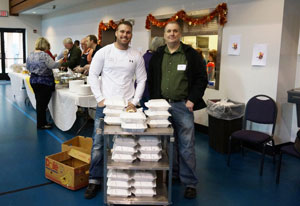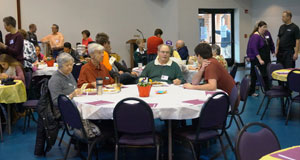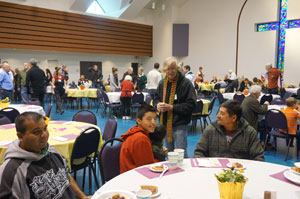 GASTONIA — RCIA coordinator, children’s book author, theology professor at St. Joseph’s College of Maine, communications liaison for the N.C. Catholic Writers Guild, Catholic blogger, and now, national Catholic speaker.
GASTONIA — RCIA coordinator, children’s book author, theology professor at St. Joseph’s College of Maine, communications liaison for the N.C. Catholic Writers Guild, Catholic blogger, and now, national Catholic speaker.
Virginia Lieto is spending more and more of her time evangelizing and communicating with Catholics, including a recent presentation on the theological virtues in Gastonia that is being taped for her work with a national Catholic speakers bureau.
St. Michael the Archangel Church hosted a mini-retreat last month featuring a segment of Lieto’s popular full-day retreat called “Living a Virtuous Life.” Lieto delivered a thought-provoking performance encouraging all to “love your enemies, do good to those who curse you, pray for those who mistreat you” (Luke 6:27). She engaged the crowd in discovering the true meaning of “charitable self-giving love,” with compelling stories from her life.
However, unlike her usual presentations, Lieto was illuminated by six huge spotlights during her talk in Gastonia. Local videographer Zac Brakefield, from Maximilian Media LLC, with about five video cameras rotating around Lieto, turning the parish’s Family Life Center into Lieto’s first videotaped event.
“This is no different than giving a presentation without being filmed. My focus is on the participants, with the goal of making sure that each person leaves feeling like they learned something new,” Lieto said. “Zac’s process of filming is very non-invasive. He is a true pro. It is very easy to work with him.”
“Ginny is going to knock their socks off,” said Brakefield, referencing Lieto’s new connection with www.cmgbooking.com, a top resource worldwide for Catholic speakers.
After a lengthy process of submitting writing samples, references and her resume, Lieto received an invitation to join an elite fleet of 300 highly recommended national Catholic motivational speakers. Maximilian Media LLC filmed the event to give Lieto the demo tape needed for her profile page with the booking agency.
Lieto said she felt extremely fortunate to work with Brakefield, as he is known throughout the Diocese of Charlotte for providing quality videos for weddings and other events, as well as testimonials, marketing and corporate videos.
Overall, Lieto reminds people that she has a very simple philosophy: “If you want to learn how to be a good Catholic, embrace the virtues.”
With God’s help, she said she hopes to evangelize Catholics all over the world through her award-winning blog, www.virginialieto.com, children’s book and speaking engagements.
Where does she go from here? She replies, “I have no idea where the Holy Spirit is taking me. I wake up every day and see what happens. I know God will take care of everything.”
— Lisa Geraci, correspondent
‘A very blessed Thanksgiving Day’
 MOORESVILLE — Our community Thanksgiving meal at St. Thérèse Church began in 2013 when we realized there was a need to work together to provide a nourishing meal and give back to the community.
MOORESVILLE — Our community Thanksgiving meal at St. Thérèse Church began in 2013 when we realized there was a need to work together to provide a nourishing meal and give back to the community.
There were many who were lonely with no family in the area and in need of someone to share this holiday. We found that there was no organization in the area that was providing a Thanksgiving meal, so it was up to us.
We formed a committee to review our options. We talked about a sit-down meal with servers or a buffet serving line, what food to serve and how to prepare it. Christine Leal (parish office assistant) discussed it with the Mooresville Christian Mission and the Mooresville Soup Kitchen. Parishioners Pete and Erin Trawinski agreed to run the kitchen. Pete is a professional chef trained at the Culinary Institute of America in New York. Erin, a middle school social studies teacher, was a server-trainer when she was in college.
Pictured: Wendy Tobin and Bob Gormley have volunteered from the beginning with their two sons. (Archival photos provided by St. Therese Church)
The first year we worked closely with the Christian Mission and the Soup Kitchen. They helped us with inclusive language and some organizing. With help we applied for an Iredell County Community Foundation grant. We didn’t get the grant but we learned a great deal about grant applications and timing. God graced us with a surprise gift of $2,000 from a couple who believed in our mission and wanted to be a part of this community meal.
In 2013 we had more volunteers than people to serve but again we learned much about organizing, ordering and preparing for this event. By the time planning began for year two, the Christian Mission and the Soup Kitchen had new management and were far less involved with the meal. They had given us a good foundation and we were able to pull it off. They still supply the moral support.
By year three (2016) we felt prepared for anything. We applied for a grant from the Diocese of Charlotte and were blessed to get it. That added another $2,000 to the pot. Our parish supporters were right there again to help us with a wonderful contribution. We now have a group of faithful, hardworking volunteers who make the days of preparation and Thanksgiving Day itself much lighter work. Another professional chef, a family of four who does the grunt work in the kitchen, neighbors of the church, and people from the Bereavement Ministry who help every year add to our cadre of volunteers. They make sure tables are set, flatware prepared, decorations arranged, turkeys carved, trash emptied, boxes recycled and so much more.

 Two volunteers pose with Thanksgiving meals that will be delivered to the community.We start cooking turkeys on the Monday before Thanksgiving. We cook from 8 a.m. until 6 p.m. Monday, Tuesday and Wednesday. This year we will roast 60 turkeys and many pounds of drumsticks and thighs. On Thanksgiving Day the cooking begins at 6:30 a.m.
Two volunteers pose with Thanksgiving meals that will be delivered to the community.We start cooking turkeys on the Monday before Thanksgiving. We cook from 8 a.m. until 6 p.m. Monday, Tuesday and Wednesday. This year we will roast 60 turkeys and many pounds of drumsticks and thighs. On Thanksgiving Day the cooking begins at 6:30 a.m.
Restaurants in the area provide lunch for the volunteers during turkey cooking early in the week, and we have even have bagels supplied by local businesses. Publix, BJ’s, Lowe’s Foods and Walmart supply gift cards or cakes and pies.
We also have volunteers taking food trays to the police, firemen, Davidson College students who can’t get home for the holiday, Lake Norman Regional Medical Center staff working during the holiday and several Hospice houses in the area. We fed more than 1,300 people last year. We were also able to help a few families who were without any means for the holiday with lodging, food and money for gas.
 Professional chefs Peter Trawinski and Peter Nowack prepare for the Thanksgiving meal. Over the past three years we have cooked 150 turkeys (about 1,200 pounds), dressing, mashed potatoes, green beans, cranberry sauce, rolls and desserts. Any leftovers are taken to the 5th Street Mission in Statesville, so nothing goes to waste.
Professional chefs Peter Trawinski and Peter Nowack prepare for the Thanksgiving meal. Over the past three years we have cooked 150 turkeys (about 1,200 pounds), dressing, mashed potatoes, green beans, cranberry sauce, rolls and desserts. Any leftovers are taken to the 5th Street Mission in Statesville, so nothing goes to waste.
Christine and I have found that this is one of the most rewarding jobs we can do for our community. It is a great way to spend our Thanksgiving. We still spend it with family…our families volunteer at this meal, too. It is a very blessed Thanksgiving Day.
— Rosemary Hyman, Special to the Catholic News Herald. Rosemary Hyman is a longtime parishioner and liturgy coordinator at St. Thérèse Church in Mooresville.
‘So much more than just a meal’
Erin Trawinski, Volunteer since the parish’s meal outreach began
 Trawinski has helped cook the food, organize jobs/responsibilities in the kitchen before, during and after the meal, set-up of the serving stations and the kitchen, clean-up, and helping to keep things running smoothly in the kitchen and on the serving line.
Trawinski has helped cook the food, organize jobs/responsibilities in the kitchen before, during and after the meal, set-up of the serving stations and the kitchen, clean-up, and helping to keep things running smoothly in the kitchen and on the serving line.
Her husband Pete is a chef and helps organize the preparation of the food before, during and after the meal, cooks on the day of the event, helps prepare extra food to go to other organizations that would benefit from the food, and assists with ordering the food prior to the meal.
Her 8-year-old daughter Katy also spends the day with them, helping in any way that she can. “She loves being able to help on this day!”
“I feel that this is such a wonderful opportunity to give thanks for the blessings I have received, but to also help others. As a family, it is very important for us to teach our children about giving back to the community. By participating in this activity together, we can set a good example for our children and show them that Thanksgiving is so much more than just a meal. It’s about giving thanks, helping others, and coming together as a community.
“I hope people who volunteer and share in the Thanksgiving meal at St. Therese for Thanksgiving come to know that our parish is an important part of the community and that we want to spread the love of God through fellowship and giving. We open our doors and hearts to anyone who wants to join us on that day or any other time, regardless of their church affiliation or beliefs.
“I also want to add that there are volunteers who help each year that do not attend our church, but spend all day helping in any way that they can. They will wash dishes, sweep the floor, cut turkey - whatever needs to be done to help make the day run smoothly. I look forward to seeing those familiar faces each year and working together to make this Thanksgiving meal a success!”
Mary Lou Caplis, Third year volunteering at the Thanksgiving Day meal
 Jesuit Father Don Ward speaks to guests at a Thanksgiving meal held in the St. Therese Parish Center.Caplis helps cook the turkeys Monday through Wednesday, does prep work, organizes food donations and helps set up for the meal. Her granddaughter helps serve the desserts.
Jesuit Father Don Ward speaks to guests at a Thanksgiving meal held in the St. Therese Parish Center.Caplis helps cook the turkeys Monday through Wednesday, does prep work, organizes food donations and helps set up for the meal. Her granddaughter helps serve the desserts.
“It is very satisfying to see the people come to this dinner and that they feel welcomed and loved. Also, Rosemary and Christine are an inspiration to St. Thérèse Church and our community.
“I’ll end with a hymn we sing: ‘All are welcome, all are welcome, all are welcome in this place.’ God bless everyone. God bless St. Thérèse Parish and happy Thanksgiving!”

